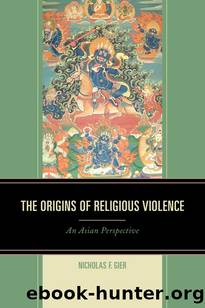The Origins of Religious Violence: An Asian Perspective by Nicholas F. Gier

Author:Nicholas F. Gier [Gier, Nicholas F.]
Language: eng
Format: epub
Tags: Religion, Eastern, General, Social Science, Violence in Society, Religious Intolerance; Persecution & Conflict, undefined
ISBN: 9780739192221
Google: 0LBhBAAAQBAJ
Amazon: 0739192221
Goodreads: 22503387
Publisher: Lexington Books
Published: 2014-08-19T22:00:00+00:00
The Rise of Tibetan Tantric Rituals in the
Ninth Century CE
The 212 years between the death of Lang Darma and the coming of Atiśa in 1042 have been traditionally considered the Tibetan Dark Ages. In his book Taming of the Demons: Violence and Liberation in Tibetan Buddhism, Jacob Dalton acknowledges that this was indeed a time of political and religious fragmentation, but not theological degeneration. Dalton argues that, contrary to previous views, this period was a time of religious innovation and experimentation. Indeed, Dalton contends that this was a time in which the Tibetans made Buddhism truly their own religion.
Access to tantric texts were restricted under imperial central authority, and tantric practices emerged with great vigor after the empire’s decline. According to later Tibetan authorities, the most disturbing aspects of this new popular Buddhism were rituals that included both sexual relations with yoginis and violent acts of liberation or demon taming. In one text Dalton found that the liberation rites could cause the victim to have “serious illness,” cause “destruction or torment,” or end in the death of a live human sacrifice.[25] (In chapter 2 we saw that human sacrifices were involved in early medieval goddess worship in South India.) Living human offerings were eventually replaced by animals and effigies, and the same rites continue to be performed by Tibetan Buddhists of all sects today. A transition from living sacrifice to effigy can be seen in this ambiguous instruction: “Having led forth the evil one, take the effigy. . . .”[26]
Dalton’s translation of a ninth-century tantric text The Great Compendium of Intentions Sūtra contains the longest version of the taming of Rudra/Śiva by wrathful Buddhas and the description of what appears to be ritual human sacrifice. Rudra of course is a Hindu deity and tantric Buddhists appropriated a long Hindu tradition of demon taming and ritual sacrifice. The concept itself is found as early as the Puruṣa Hymn of the Ṛg-veda in which a primal man is dismembered in the creation of the physical and social world. With the demise of the Gupta Empire (320–550 CE) the Tantras came to prominence and Hindu kings were more inclined to employ tantric priests as a way of protecting their domains in more chaotic times. With their transgressive actions and their siddhi powers, tantric yogis, as Dalton states, gained “the respect and patronage of kings.”[27]
One could easily imagine the primal Vedic puruṣa “staked out” as the founding demoness of Tibet was, as well as the sacrificial victims/effigies that were offered in tantric liberation rites. One Buddhist Tantra contains the language of “pressing” harmful demons, which refers to an ancient practice of “staking out” a living human body for its “compassionate” liberation from evil, for example, holding anti-Buddhist beliefs.[28] Tibetan stupas and temples also serve to “press” and tame indigenous deities, and the twelve stakes that hold down the original Tibetan demoness mark the places where major monasteries would eventually arise. In some practices the officiating lama uses a ritual dagger and stabs in ten different directions in order to secure a sacred domain protected on all sides.
Download
This site does not store any files on its server. We only index and link to content provided by other sites. Please contact the content providers to delete copyright contents if any and email us, we'll remove relevant links or contents immediately.
Cecilia; Or, Memoirs of an Heiress — Volume 1 by Fanny Burney(31333)
Cecilia; Or, Memoirs of an Heiress — Volume 3 by Fanny Burney(30934)
Cecilia; Or, Memoirs of an Heiress — Volume 2 by Fanny Burney(30889)
The Great Music City by Andrea Baker(21313)
We're Going to Need More Wine by Gabrielle Union(18073)
Bombshells: Glamour Girls of a Lifetime by Sullivan Steve(13108)
Pimp by Iceberg Slim(12931)
All the Missing Girls by Megan Miranda(12748)
Fifty Shades Freed by E L James(12451)
Norse Mythology by Gaiman Neil(11883)
Talking to Strangers by Malcolm Gladwell(11877)
Crazy Rich Asians by Kevin Kwan(8349)
Mindhunter: Inside the FBI's Elite Serial Crime Unit by John E. Douglas & Mark Olshaker(7834)
The Lost Art of Listening by Michael P. Nichols(6474)
Enlightenment Now: The Case for Reason, Science, Humanism, and Progress by Steven Pinker(6405)
Bad Blood by John Carreyrou(5769)
The Four Agreements by Don Miguel Ruiz(5511)
Weapons of Math Destruction by Cathy O'Neil(5037)
We Need to Talk by Celeste Headlee(4869)
